List of Authors
>>About this blog
Recent blog post
|
[CAM]
October 15, 2017 18:00
Earlier, I mentioned that there was no English explanation on the explanation board in the neighborhood of Ningyocho, but it seems that a considerable number of explanation boards in the ward have changed to English notation. For example, those installed at Harumi's "Japan World Exposition Secretariat Building Remains" and Tsukuda's "Sea House Remains".
The "Shikaikan Ruins" explanation board is displayed as March 2009 (2009), so it was installed more than 8 years ago. (It was clear that the photos listed in the "Citizens' Historic Site" section of "Monoshiri Encyclopedia" were taken when they were not written in English, but the latest published in October 2017 In the edition, it seems that it was finally replaced with the latest photo.)
When explaining in English, for example, if you say that most of Chuo-ku is a landfill (reclaimed land), this may contain multiple Rs and L, so it can be understood only by verbally. I feel unrecognized. For example, according to the dictionary, "reclaim" is used to reclaim the sea and "fill up" is used to reclaim ponds and rivers, so it can be mistranslations.
In order to avoid misunderstandings, I think it would be better to have a pattern of verbally speaking the main points while giving explanations in English instead of verbally communicating.
In a certain Asian country, the driver flies too much, so when I said "Safety First", I was turned around with a shaky expression and I was about to shout, "Isn't it dangerous!" When I thought later, the phrase "Safety First" was Japanese English, and it seemed that I heard "First" as "Fast" (fast). If you say "Safety Fast", it's natural to be surprised.
In that way, there is an unexpected misunderstanding just by verbally. Including such meaning, the explanation board in the ward should be changed to one that is written in English as soon as possible.
Description board for "Saikaikan Ruins"
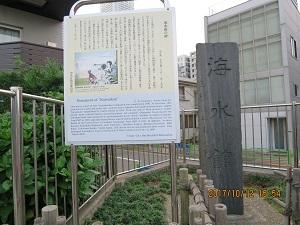
[CAM]
October 12, 2017 16:00
The Nihon Keizai Shimbun's regional economic aspect (Tokyo) on October 11, 2017 reported the establishment of "Nihonbashi Information" (Tourist Information Center) as an example of the establishment of a system for accepting foreign tourists in Chuo-ku. . In addition, Chuo-ku plans to increase the attractiveness of Tokyo's leading sightseeing spots, such as adding information signs in foreign languages so that you can enjoy walking around the city with peace of mind, and enhancing the Internet environment. It has been stated. According to the article, 48% of visitors to Tokyo visit Ginza and 37% visit Nihonbashi (including around Tokyo Station and Marunouchi) (Tokyo 2016 survey).
It means "addition of information signs in foreign languages", but in the case of foreign language notation, I think that it is necessary to have an English part that shows the contents, not just Romanization of Japanese. At present, there are signs that are limited to Romanization only. For example, you should not only display "Amazakeyokocho", but also add "Alley", "Street", etc. Foreigners who cannot understand Japanese simply by Romanization of place names do not understand the "contents" at all.
This English notation of the place name is important, and when I moved alone in Russia and other Russian areas, I couldn't even pronounce the street display of the city, so I was lost and could send it to the promised time Even if I could not contact my current location, and I had a problem (at that time, I was not in a situation where I could use my mobile phone overseas). It was my experience in Moscow, but I was dropped off on the way by a taxi I picked up in the city, I could hardly speak English in the city, and with the help of a young man who caught me, he told me that you were a brave man. It was about 10 years after the collapse of the Soviet Union, and I was reminded that general taxis in Moscow were notorious, and even a little expensive, they were told that they should not ride anything other than the taxi they applied for at the hotel.
Also, during the preliminary survey of the "October 8 Welcome Central Inbound Tour", when I walked around Ningyocho, I was dissatisfied that a considerable number of explanation versions in the city did not include English explanations only in Japanese explanations . I think that I was able to confirm only the English explanation of two Karakuri dolls, except for the signboards set up by the ward's Board of Education.
Nihonbashi Information
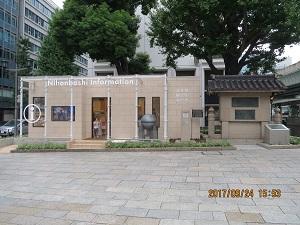
[CAM]
October 8, 2017 18:00
I read that some of the people wrote about a sushi restaurant called "Sukiyabashi Jiro" and reviewed the related materials I owned.
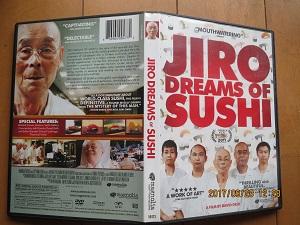
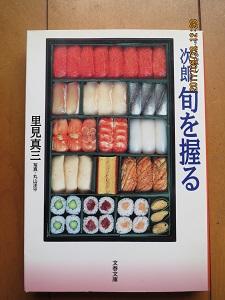
The DVD "JIRO DREAMS OF SUSHI" was produced in 2011 (voice is Japanese and English subtitles). The book "Sukiyabashi Jiro Jiro Shun" was published in 1997 and the paperback version was published in 2001. I don't like artisans, entertainers, sportsmen, etc. to give strange lectures and lessons, but I don't feel that bad on this DVD.
Poor people like me can't enter a high-end sushi restaurant that costs more than 30,000 yen at a time, and I don't want to enter at all, but I went to visit only for the location and appearance of the store for reference I have. This sentence describes "history and culture" instead of "gourmet information".
As your eldest son stated, the question is how to maintain the operation of the store after the death of this charismatic husband.
[CAM]
October 6, 2017 14:00
http://www.nihonbashi-tokyo.jp/enjoy/gem/201212/
>Futaba (2-4-9 Nihonbashi Ningyocho) is a tofu shop located in amazake Yokocho, Ningyocho. It is said that after its founding in Fukagawa, it moved to this area in 1948. It is an attractive shop with a wide selection of products.
"Bamboo Tofu" in a tasteful bamboo tube has an anecdote unique to Nihonbashi. In the past, restaurants lined up along the Sumida River, offering cherry blossom viewing in spring, fireworks in summer, and moon viewing houseboats in autumn. Therefore, tofu was popular as a product to offer, but it often jumped out of the glass vessel due to the shaking of the boat, so he came up with a product poured into a bamboo cylinder as a measure to prevent it.
>The famous "Jumbo Ganmo" is a product born from the playfulness of the third generation. About 30 years ago, we repeated cancers of different sizes and sold them as "offering cancers" at the end of the year, and gained a reputation as "delicious", and sold them as a whole year product. When boiling at home, the trick is to boil it before seasoning. The tie-up Yamatoimo swells softly and makes it easy to taste. "In the coming season, tofu goes well with pots and odens."
Be sure to visit, buy several kinds of tofu, and enjoy the deliciousness of soybeans to your heart's content.
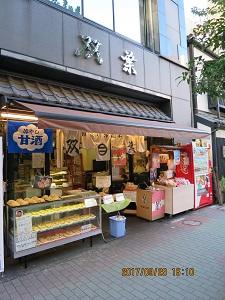

[CAM]
October 6, 2017 14:00
"Ningyo Market" has started. This is the twelfth time, and this year is 3 days on October 5 (Thu), 6 (Fri), and 7 (Sat). When this is over, Sunday, October 8 is the Tenten Festival. In addition, "Happy Halloween Rally 2017" will be held on October 28 (Saturday), and fun projects will continue one after another in Ningyocho. The following is the sight of Ningyoichi on the evening of October 5th.
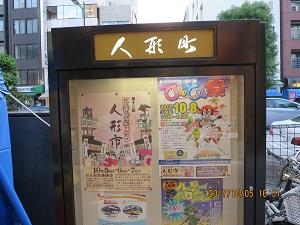
Near the exit of Metro Station

Near the Karakuri doll (fire extinguishing)
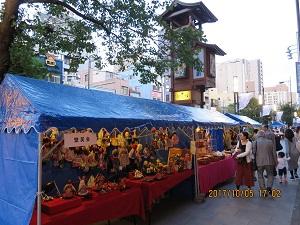
[CAM]
12:00 on October 5, 2017
http://www.nihonbashi-tokyo.jp/enjoy/gem/201201/
Ningyocho was crowded with Kabuki, Joruri, and puppet shows during the Edo period. Ningyo-yaki Honpo Itakuraya (2-4-2 Ningyocho, Chuo-ku, Tokyo) has been keeping the traditional taste for more than a hundred years since its establishment. Originally known as "Yakimanju", it was loved by people who visited the play. Later, it is said that the first generation named it "Ningyo-yaki" after the name of Ningyocho.

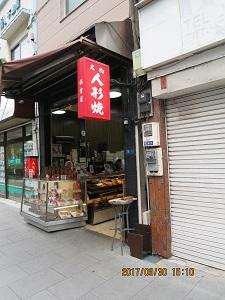
The figure of Ningyo-yaki is the Seven Lucky Gods. It was a whole body image at the time of its founding, but now only faces are lined up. Hoteison, Benzaiten, Ebisu, Bishamon, Daikokuten, Jujin, Benzaiten, I can't see the faces of Fukurokuju. "Our doll ware is the six gods. We will become the Seven Lucky Gods together with our customers' smiles, "says the fourth generation, Yuta Fujii.
It is sold from one at the store, and you can also have freshly baked goods. From the crisp, fragrant skin, soft and plump bean paste looks into your face, and it is unique. I am surprised by the contrast of the texture. As the fourth generation said, "The taste of the next day is good," when you leave it for a day, the skin and bean paste blend in moistly, and you can enjoy a gentle taste again.
Since its establishment, we have been protecting hand-baked and examining the ingredients. The fine dough is made by adding sugar and honey to egg yolk and laying overnight, and the next morning, mixed with meringue-shaped egg white and flour. "By sleeping overnight, the coarse particles of sugar become softer." The bean paste is a blend of azuki varieties called Azuki and Shumari from Tokachi. In addition, there are "wartime ware" without bean paste, and sweets shaped like sweetfish, which is said to be a clean and happy fish from living in the clear stream.
Ningyo-yaki was born in Ningyocho. I'd like you to appreciate Seven Lucky Gods's face.
|
Links
|

